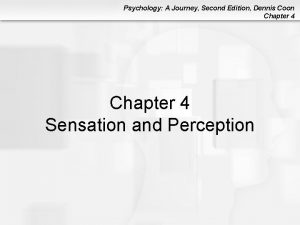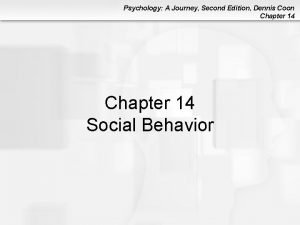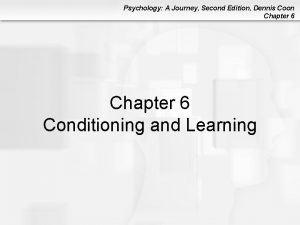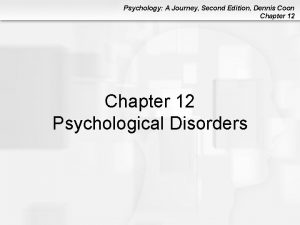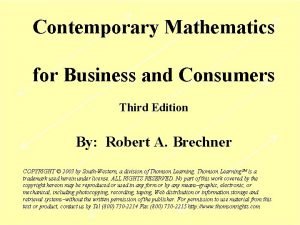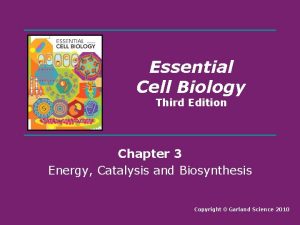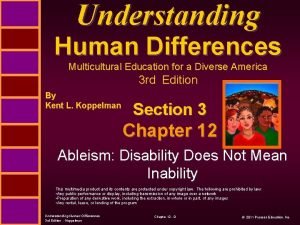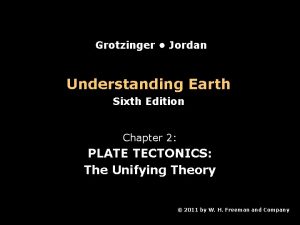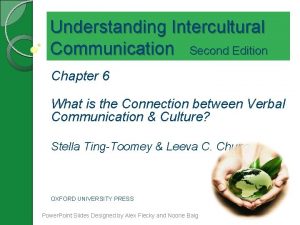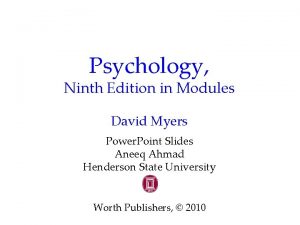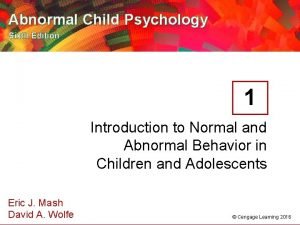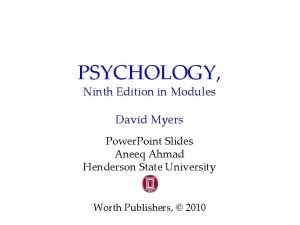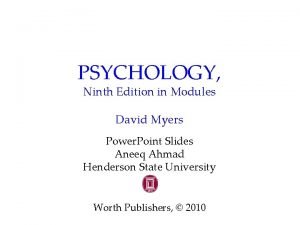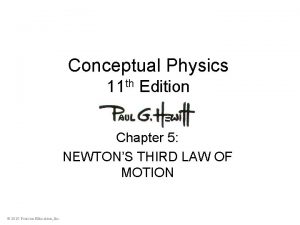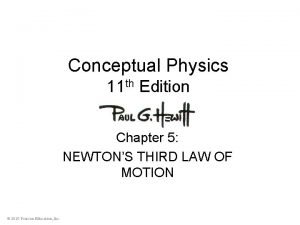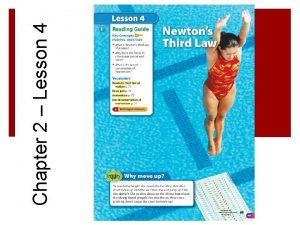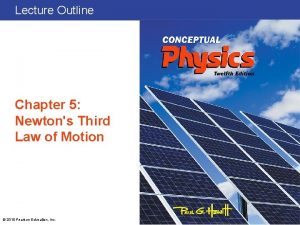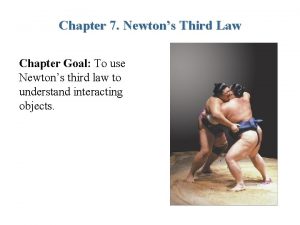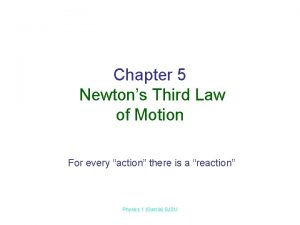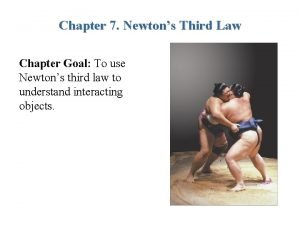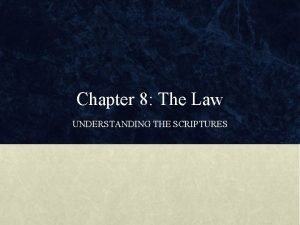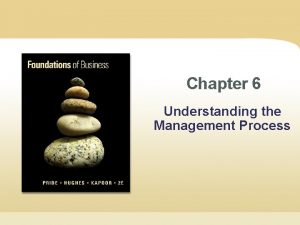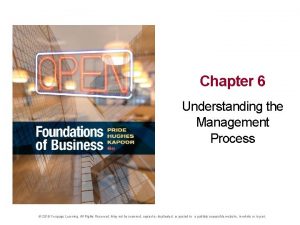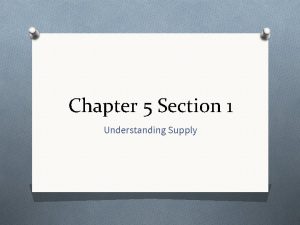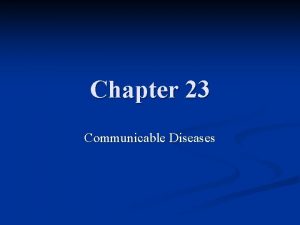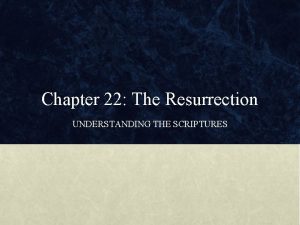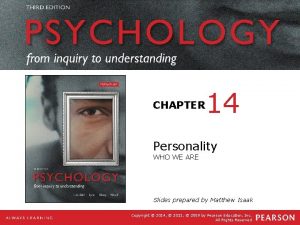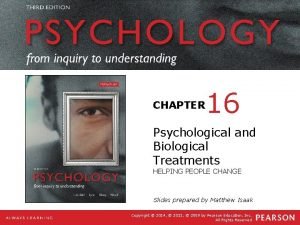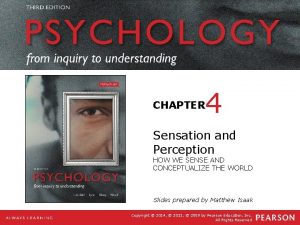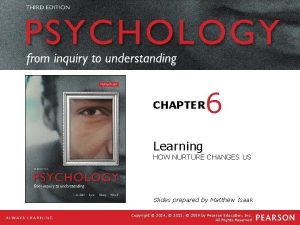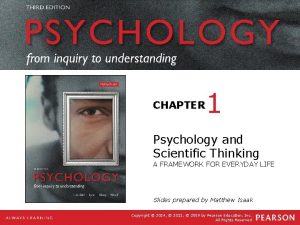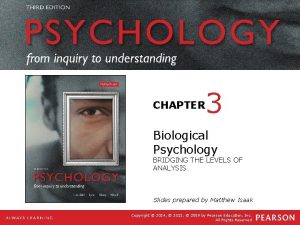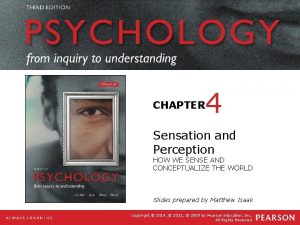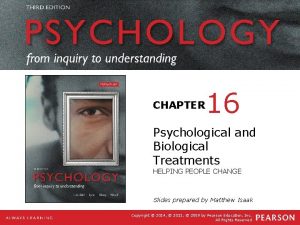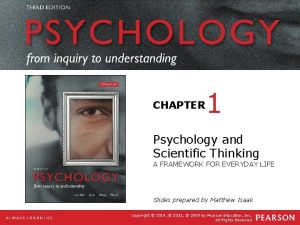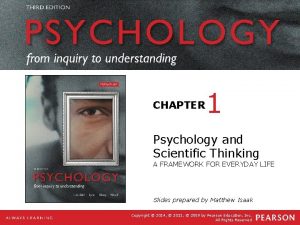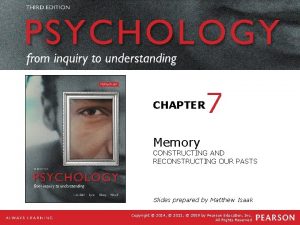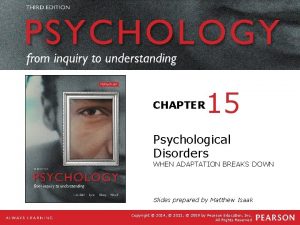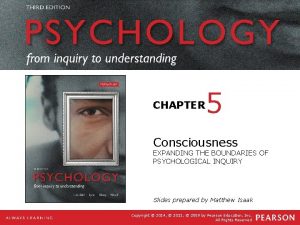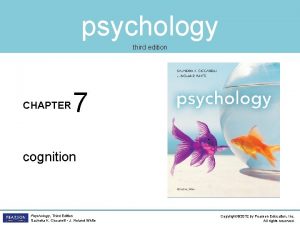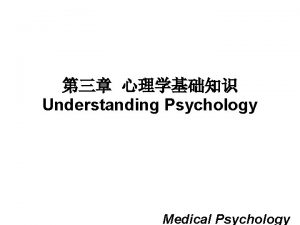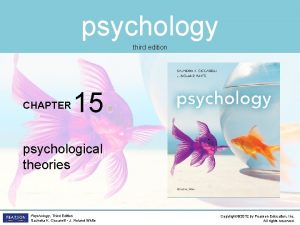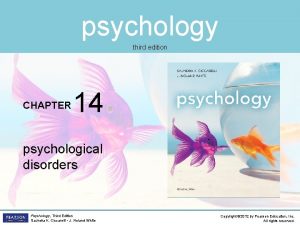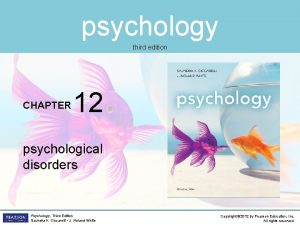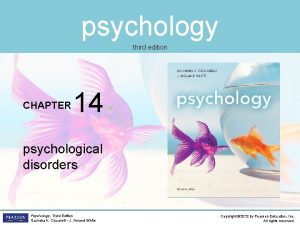THIRD EDITION PSYCHOLOGY from inquiry to understanding CHAPTER


































































- Slides: 66

THIRD EDITION PSYCHOLOGY from inquiry to understanding CHAPTER 2 Research Methods SAFEGUARDS AGAINST ERROR Slides prepared by Matthew Isaak Copyright © 2014, © 2011, © 2009 by Pearson Education, Inc. All Rights Reserved

Lecture Preview • The beauty and necessity of good research design • The scientific method • Ethical issues in research design • Statistics • Evaluating psychological research Understanding Psychology: from Inquiry to Understanding , Third Edition Lilienfeld | Lynn | Namy | Woolf

Why We Need Research Designs LO 2. 1 Identify two modes of thinking and their application to scientific reasoning. • In the early 1990 s, an autism treatment was developed called "facilitated communication. " • The developers thought that autism was a motor disorder. • The facilitator sat next to child with autism and guided the child's hand over a keyboard, allowing the children to type out words. Understanding Psychology: from Inquiry to Understanding , Third Edition Lilienfeld | Lynn | Namy | Woolf

Why We Need Research Designs LO 2. 1 Identify two modes of thinking and their application to scientific reasoning. • Students seemed to make stunning progress in communication, telling parents "I love you" and writing poetry. • However, some students began making allegations of sexual abuse against parents. • There was no physical evidence, just the communicators via the facilitators. Understanding Psychology: from Inquiry to Understanding , Third Edition Lilienfeld | Lynn | Namy | Woolf

Why We Need Research Designs LO 2. 1 Identify two modes of thinking and their application to scientific reasoning. • Dozens of controlled studies examined the phenomenon and found that the words came solely from the minds of the facilitators. • Still, some people continue to practice facilitated communication. Understanding Psychology: from Inquiry to Understanding , Third Edition Lilienfeld | Lynn | Namy | Woolf

Figure 2. 1 Putting Facilitated Communication to the Test. Understanding Psychology: from Inquiry to Understanding , Third Edition Lilienfeld | Lynn | Namy | Woolf

Why We Need Research Designs LO 2. 1 Identify two modes of thinking and their application to scientific reasoning. • Even well-educated, intelligent people can be fooled. • Well-planned designs can help to eliminate biases when examining phenomena. Understanding Psychology: from Inquiry to Understanding , Third Edition Lilienfeld | Lynn | Namy | Woolf

Why We Need Research Designs LO 2. 1 Identify two modes of thinking and their application to scientific reasoning. • Prefrontal lobotomy is example of what happens when we rely on subjective impressions. • Developer won the Nobel Prize • In it, the neural fibers connecting frontal lobes to the thalamus were severed. • Control studies showed it didn't work. Understanding Psychology: from Inquiry to Understanding , Third Edition Lilienfeld | Lynn | Namy | Woolf

Common Sense LO 1. 1 Explain why psychology is more than just common sense. Most of us trust our gut intuitions about how the world works. Birds of a feather flock together. Opposites attract. Absence makes the heart grow fonder. Out of sight, out of mind. Better safe than sorry. Nothing ventured, nothing gained. Two heads are better than one. Too many cooks spoil the broth. Actions speak louder than words. The pen is mightier than the sword. Even though each of these ring true, they are in fact opposites! Understanding Psychology: from Inquiry to Understanding , Third Edition Lilienfeld | Lynn | Namy | Woolf

Naïve Realism LO 1. 1 Explain why psychology is more than just common sense. • The belief that we see the world precisely as it actually is in truth – “seeing is believing” Works well in ordinary life, but consider: – The earth seems flat. – We seem to be standing still, yet the earth is moving around the sun 18. 5 miles/sec. Understanding Psychology: from Inquiry to Understanding , Third Edition Lilienfeld | Lynn | Namy | Woolf

Which table is longer? LO 1. 1 Explain why psychology is more than just common sense. These two tabletops are identical in length. Understanding Psychology: from Inquiry to Understanding , Third Edition Lilienfeld | Lynn | Namy | Woolf

When Common Sense is Right LO 1. 1 Explain why psychology is more than just common sense. • Not all common sense is wrong. • Common sense should serve as a generator for hypotheses, which can then be tested. • But learning to think like a scientist means learning when—and when not— to trust our common sense. Understanding Psychology: from Inquiry to Understanding , Third Edition Lilienfeld | Lynn | Namy | Woolf

Theories and Hypotheses LO 1. 2 Explain the importance of science as a set of safeguards against biases. • A scientific theory is an explanation for a large number of findings in the natural world. • A hypothesis is a specific prediction based on a theory, which can then be tested. • Theories are general explanations; hypotheses are specific predictions derived from them. Understanding Psychology: from Inquiry to Understanding , Third Edition Lilienfeld | Lynn | Namy | Woolf

Theory Misconceptions LO 1. 2 Explain the importance of science as a set of safeguards against biases. “A theory explains one specific event. ” “A theory is just an educated guess. ” Why are these both wrong? Understanding Psychology: from Inquiry to Understanding , Third Edition Lilienfeld | Lynn | Namy | Woolf

Science as a Safeguard against Bias LO 1. 2 Explain the importance of science as a set of safeguards against biases. • Confirmation bias – Tendency to seek out evidence that supports our hypothesis and neglect or distort contradicting evidence • Scientists need to design studies that may disprove their theories. Understanding Psychology: from Inquiry to Understanding , Third Edition Lilienfeld | Lynn | Namy | Woolf

Figure 1. 3 Diagram of Wason Selection Task. In the Wason selection task, you must pick two cards to test the hypothesis that all cards that have a vowel on one side have an odd number on the other. Which two will you select? Understanding Psychology: from Inquiry to Understanding , Third Edition Lilienfeld | Lynn | Namy | Woolf

Science as a Safeguard against Bias LO 1. 2 Explain the importance of science as a set of safeguards against biases. • Belief perseverance – Tendency to stick to our initial beliefs even when evidence contradicts them • The “don’t confuse me with the facts” bias Understanding Psychology: from Inquiry to Understanding , Third Edition Lilienfeld | Lynn | Namy | Woolf

Metaphysical Claims LO 1. 2 Explain the importance of science as a set of safeguards against biases. • Non-testable assertions that fall outside the realm of science – The existence of God, the soul, or the afterlife Understanding Psychology: from Inquiry to Understanding , Third Edition Lilienfeld | Lynn | Namy | Woolf

FIGURE 1. 4 Nonoverlapping Realms. Scientist Stephen Jay Gould (1997) argued that science and religion are entirely different and nonoverlapping realms of understanding the world. Science deals with testable claims about the natural world that can be answered with data, whereas religion deals with untestable claims about moral values that can’t be answered with data. Although not all scientists and theologists accept Gould’s model, we adopt it for the purposes of this textbook. (Source: Gould, 1997) Understanding Psychology: from Inquiry to Understanding , Third Edition Lilienfeld | Lynn | Namy | Woolf

We Might Be Wrong LO 1. 2 Explain the importance of science as a set of safeguards against biases. • Good scientists are aware they might be wrong. • Scientific knowledge is always tentative and open to revision. • Science forces us to question our findings and conclusions. Understanding Psychology: from Inquiry to Understanding , Third Edition Lilienfeld | Lynn | Namy | Woolf

Thinking Clearly LO 1. 4 Identify reasons we are drawn to pseudoscience. • Learning to think scientifically can help us avoid falling prey to pseudoscience. • Emotional reasoning fallacy—using emotions rather than evidence as the guide • Bandwagon fallacy—Lots of people believe it, so it must be true. • “Not me” fallacy—Other people may have those biases, but not me. Understanding Psychology: from Inquiry to Understanding , Third Edition Lilienfeld | Lynn | Namy | Woolf

Why Should We Care? LO 1. 4 Identify reasons we are drawn to pseudoscience. • Because pseudoscience can be very dangerous. • Three major reasons to be concerned: – Opportunity cost – Direct harm – Inability to think scientifically • Although not foolproof, scientific thinking is our best safeguard against human error. Understanding Psychology: from Inquiry to Understanding , Third Edition Lilienfeld | Lynn | Namy | Woolf

Scientific Skepticism LO 1. 5 Identify the key features of scientific skepticism. • Being scientifically skeptical does not mean being closed-minded. • Evaluate claims with an open mind, but insist on persuasive evidence before accepting them. • Skeptics are willing to change their minds, but must have good evidence before doing so. Understanding Psychology: from Inquiry to Understanding , Third Edition Lilienfeld | Lynn | Namy | Woolf

Critical Thinking LO 1. 6 Identify and explain the text’s six principles of scientific thinking. • A set of skills for evaluating all claims in a open-minded and careful fashion • This allows us to overcome our own biases (especially the confirmation bias). • Six critical thinking principles will be emphasized in this course. Understanding Psychology: from Inquiry to Understanding , Third Edition Lilienfeld | Lynn | Namy | Woolf

Critical Thinking Principles LO 1. 6 Identify and explain the text’s six principles of scientific thinking. • Ruling out rival hypotheses – Have important alternate explanations for the finding been considered? • Correlation isn’t causation – Can we be sure A causes B? • Falsifiability – Can the claim be disproven? Understanding Psychology: from Inquiry to Understanding , Third Edition Lilienfeld | Lynn | Namy | Woolf

Critical Thinking Principles LO 1. 6 Identify and explain the text’s six principles of scientific thinking. • Replicability – Can the results be duplicated in other studies? • Extraordinary claims require extraordinary evidence – Is the evidence as convincing as the claims? Understanding Psychology: from Inquiry to Understanding , Third Edition Lilienfeld | Lynn | Namy | Woolf

Critical Thinking Principles LO 1. 6 Identify and explain the text’s six principles of scientific thinking. • Occam’s razor – Does a simpler explanation fit the data just as well? – Parsimony: logical simplicity Understanding Psychology: from Inquiry to Understanding , Third Edition Lilienfeld | Lynn | Namy | Woolf

Figure 2. 2 The Prefrontal Lobotomy. Understanding Psychology: from Inquiry to Understanding , Third Edition Lilienfeld | Lynn | Namy | Woolf

Two Modes of Thinking LO 2. 1 Identify two modes of thinking and their application to scientific reasoning. System I or intuitive thinking • Quick, reflexive, almost automatic • Relies on heuristics System 2 or analytical thinking • Slow, reflexive, effortful Understanding Psychology: from Inquiry to Understanding , Third Edition Lilienfeld | Lynn | Namy | Woolf

Two Modes of Thinking LO 2. 1 Identify two modes of thinking and their application to scientific reasoning. • Heuristics are mental shortcuts or rules of thumb that we use daily. – They reduce the cognitive energy required to solve problems but we oversimplify reality. • Imagine yourself driving from Reno, Nevada to San Diego, California—which compass direction would you take? Understanding Psychology: from Inquiry to Understanding , Third Edition Lilienfeld | Lynn | Namy | Woolf

San Diego is actually EAST of Reno LO 2. 1 Identify two modes of thinking and their application to scientific reasoning. FIGURE 2. 3 In Which Compass Direction Would You Travel to Get from Reno, NV to San Diego, CA? Understanding Psychology: from Inquiry to Understanding , Third Edition Lilienfeld | Lynn | Namy | Woolf

So, how do we prevent ourselves from being fooled by our own (and other people's) biases? LO 2. 1 Identify two modes of thinking and their application to scientific reasoning. Understanding Psychology: from Inquiry to Understanding , Third Edition Lilienfeld | Lynn | Namy | Woolf

The Scientific Method Toolbox LO 2. 2 Describe the advantages and disadvantages of using naturalistic observation, case studies, self-report measures, and surveys. • Allows us to test specific hypotheses derived from broader theories of how things work. • Theories are never "proven, " but hypotheses can be confirmed or disconfirmed. • We can use a number of different types of SM tools to gain information and test hypotheses. Understanding Psychology: from Inquiry to Understanding , Third Edition Lilienfeld | Lynn | Namy | Woolf

Naturalistic Observation LO 2. 2 Describe the advantages and disadvantages of using naturalistic observation, case studies, self-report measures, and surveys. • Watching behavior in real-world settings • High degree of external validity extent to which we can generalize our findings to the real world • Low degree of internal validity extent to which we can draw cause-and -effect inferences Understanding Psychology: from Inquiry to Understanding , Third Edition Lilienfeld | Lynn | Namy | Woolf

Case Study Designs LO 2. 2 Describe the advantages and disadvantages of using naturalistic observation, case studies, self-report measures, and surveys. • Studying one person or a small number of people for an extended period of time • Common with rare types of brain damage or mental illness • Helpful in providing existence proofs, but can be misleading and anecdotal Understanding Psychology: from Inquiry to Understanding , Third Edition Lilienfeld | Lynn | Namy | Woolf

Self Report Measures and Surveys LO 2. 2 Describe the advantages and disadvantages of using naturalistic observation, case studies, self-report measures, and surveys. • Psychologists often need to ask people about themselves or others. – Self-report measures or questionnaires asses characteristics such as personality or mental illness. – Surveys ask about a person's opinions or abilities. • Not all measures and surveys are equal. Understanding Psychology: from Inquiry to Understanding , Third Edition Lilienfeld | Lynn | Namy | Woolf

Random Selection LO 2. 2 Describe the advantages and disadvantages of using naturalistic observation, case studies, self-report measures, and surveys. • The key to generalizability in surveys and questionnaire studies – Ensures every person in a population has an equal chance of being chosen to participate • Non-random selection can skew results and make them inaccurate when applied to the population as a whole. Understanding Psychology: from Inquiry to Understanding , Third Edition Lilienfeld | Lynn | Namy | Woolf

Evaluating Measures LO 2. 2 Describe the advantages and disadvantages of using naturalistic observation, case studies, self-report measures, and surveys. • To trust results, the measures must have: – Reliability—consistency of measurement – Validity—extent to which a measure assesses what it claims to measure • A test must be reliable to be valid, but a reliable test can still be completely invalid. Understanding Psychology: from Inquiry to Understanding , Third Edition Lilienfeld | Lynn | Namy | Woolf

Self-Report Measures LO 2. 2 Describe the advantages and disadvantages of using naturalistic observation, case studies, self-report measures, and surveys. • Pros – Easy to administer – Direct (self) assessment of person's state Understanding Psychology: from Inquiry to Understanding , Third Edition Lilienfeld | Lynn | Namy | Woolf

Self-Report Measures LO 2. 2 Describe the advantages and disadvantages of using naturalistic observation, case studies, self-report measures, and surveys. • Cons – Accuracy is skewed for certain groups (narcissists) – Potential for dishonesty – Response sets - tendencies of research subjects to distort their responses – Positive impression management – Malingering Understanding Psychology: from Inquiry to Understanding , Third Edition Lilienfeld | Lynn | Namy | Woolf

Rating Data LO 2. 2 Describe the advantages and disadvantages of using naturalistic observation, case studies, self-report measures, and surveys. • People can also be asked to rate others on different characteristics. • This can do away with some biases in self-report, but still has problems. • Halo effect—tendency of ratings of one positive characteristic to spill over to influence the ratings of other characteristics Understanding Psychology: from Inquiry to Understanding , Third Edition Lilienfeld | Lynn | Namy | Woolf

Correlational Designs LO 2. 3 Describe the role of correlational designs and distinguish correlation from causation. • Examine how two variables are related • Correlations vary from -1 to +1 and can be: – Positive (as one increases, so does the other) – Negative (as one increases, the other decreases) – Zero (no relationship between variables) • Depicted in a scatterplot Understanding Psychology: from Inquiry to Understanding , Third Edition Lilienfeld | Lynn | Namy | Woolf

Scatterplots LO 2. 3 Describe the role of correlational designs and distinguish correlation from causation. Figure 2. 4 Diagram of Three Scatterplots. Understanding Psychology: from Inquiry to Understanding , Third Edition Lilienfeld | Lynn | Namy | Woolf

Correlational Designs LO 2. 3 Describe the role of correlational designs and distinguish correlation from causation. • Illusory Correlation—perception of a statistical association where none exists – Crime rates and the full moon – Arthritis and weather • Examining a probability table helps to explain why we are all prone to seeing relationships where none exists. Understanding Psychology: from Inquiry to Understanding , Third Edition Lilienfeld | Lynn | Namy | Woolf

The Great Fourfold Table of Life LO 2. 3 Describe the role of correlational designs and distinguish correlation from causation. Did a full moon occur? Did a crime occur? Yes No Yes A) Full moon + crime B) Full moon + no crime No C) No full moon D) No full moon + crime + no crime Humans tend to overemphasize cell A and ignore the non-events. Understanding Psychology: from Inquiry to Understanding , Third Edition Lilienfeld | Lynn | Namy | Woolf

Correlation vs. Causation LO 2. 3 Describe the role of correlational designs and distinguish correlation from causation. • Just because two things are related, does not mean that one causes another. • There are three possible explanations: – A causes B – B causes A – C causes both A and B Understanding Psychology: from Inquiry to Understanding , Third Edition Lilienfeld | Lynn | Namy | Woolf

Determining Causation LO 2. 4 Identify the components of an experiment, the potential pitfalls that can lead to faulty conclusions, and how psychologists control for these pitfalls. • The only way to determine if one thing is casually related to another is via an experimental design. • This is because in an experiment, you purposefully manipulate variables, rather than just measure already existing differences. Understanding Psychology: from Inquiry to Understanding , Third Edition Lilienfeld | Lynn | Namy | Woolf

What Makes a Study an Experiment? LO 2. 4 Identify the components of an experiment, the potential pitfalls that can lead to faulty conclusions, and how psychologists control for these pitfalls. • Random assignment of participants groups – Experimental Group - receives the manipulation – Control Group - does not receive the manipulation Understanding Psychology: from Inquiry to Understanding , Third Edition Lilienfeld | Lynn | Namy | Woolf

What Makes a Study an Experiment? LO 2. 4 Identify the components of an experiment, the potential pitfalls that can lead to faulty conclusions, and how psychologists control for these pitfalls. • Manipulation of an independent variable – The dependent variable is what the experimenter measures to see whether manipulation had an effect. Understanding Psychology: from Inquiry to Understanding , Third Edition Lilienfeld | Lynn | Namy | Woolf

What Makes a Study an Experiment? LO 2. 4 Identify the components of an experiment, the potential pitfalls that can lead to faulty conclusions, and how psychologists control for these pitfalls. • Confounds - any difference between the experimental and control groups aside from IV – Makes IV effects uninterpretable • Cause and effect - possible to infer, with random assignment and manipulation of independent variable Understanding Psychology: from Inquiry to Understanding , Third Edition Lilienfeld | Lynn | Namy | Woolf

Pitfalls in Experimental Design LO 2. 4 Identify the components of an experiment, the potential pitfalls that can lead to faulty conclusions, and how psychologists control for these pitfalls. • Placebo effect - improvement resulting from the mere expectation of improvement – Participants must be blind to their assignment to groups. – Placebos show many of the same characteristics as real drugs. • Nocebo effect - harm resulting from the mere expectation of harm Understanding Psychology: from Inquiry to Understanding , Third Edition Lilienfeld | Lynn | Namy | Woolf

Pitfalls of Experimental Design LO 2. 4 Identify the components of an experiment, the potential pitfalls that can lead to faulty conclusions, and how psychologists control for these pitfalls. • Experimenter expectancy effect – when researchers' hypotheses lead them to unintentionally bias a study outcome – Clever Hans, the mathematical horse – Rosenthal's undergrads and maze-bright or maze-dull rats • Using a double-blind design can decrease this. Understanding Psychology: from Inquiry to Understanding , Third Edition Lilienfeld | Lynn | Namy | Woolf

Pitfalls of Experimental Design LO 2. 4 Identify the components of an experiment, the potential pitfalls that can lead to faulty conclusions, and how psychologists control for these pitfalls. • Demand characteristics - cues that participants pick up allowing them to guess at the researcher's hypotheses • Disguising the purpose of the study or using "filler" items can help to decrease these. Understanding Psychology: from Inquiry to Understanding , Third Edition Lilienfeld | Lynn | Namy | Woolf

Ethical Issues in Research Design LO 2. 5 Explain the ethical obligations of researchers toward their research participants. • Tuskegee study ran from 1932 to 1972 – African American men living in rural Alabama diagnosed with syphilis – U. S. Public Health Service never informed, or treated, the men; they merely studied the course of the disease. – 28 men died of syphilis, 100 of related complications, 40 wives were infected, and 19 children were born with it. Understanding Psychology: from Inquiry to Understanding , Third Edition Lilienfeld | Lynn | Namy | Woolf

Ethical Guidelines for Human Research LO 2. 5 Explain the ethical obligations of researchers toward their research participants. • Today, research has to go through a careful process of review to ensure that it is conducted ethically. • Institutional Review Board (IRB) – Informed consent – Justification of deception – Debriefing of subjects afterwards Understanding Psychology: from Inquiry to Understanding , Third Edition Lilienfeld | Lynn | Namy | Woolf

Ethical Issues in Animal Research LO 2. 6 Describe both sides of the debate on the use of animals as research subjects. • Only 7 -8% of psychological research uses animals. • Vast majority are rodents and birds • Goal is to generate ideas about the brain and behavior without harming people Understanding Psychology: from Inquiry to Understanding , Third Edition Lilienfeld | Lynn | Namy | Woolf

Statistics: The Language of Research LO 2. 7 Identify uses of various measures of central tendency and variability. • Descriptive statistics—numerical characterizations of the data set • Central tendency—where the group tends to cluster – Mean: average of all scores – Median: middle score in the data set – Mode: most frequent score in the data set Understanding Psychology: from Inquiry to Understanding , Third Edition Lilienfeld | Lynn | Namy | Woolf

Figure 2. 7 Distribution Curves. Understanding Psychology: from Inquiry to Understanding , Third Edition Lilienfeld | Lynn | Namy | Woolf

Statistics: The Language of Research LO 2. 7 Identify uses of various measures of central tendency and variability. • Variability—sense of how loosely or tightly bunched scores are • Range—difference between the highest and lowest scores • Standard deviation—measure that takes into account how far each data point is from the mean Understanding Psychology: from Inquiry to Understanding , Third Edition Lilienfeld | Lynn | Namy | Woolf

Range vs. Standard Deviation LO 2. 7 Identify uses of various measures of central tendency and variability. • Both sets of data have the same range, but very different standard deviations. • Standard deviations are less susceptible to extreme scores than ranges are. Understanding Psychology: from Inquiry to Understanding , Third Edition Lilienfeld | Lynn | Namy | Woolf

FIGURE 2. 8 The Range versus the Standard Deviation. Understanding Psychology: from Inquiry to Understanding , Third Edition Lilienfeld | Lynn | Namy | Woolf

Statistics: The Language of Research LO 2. 8 Explain how inferential statistics can help us to determine whether we can generalize from our sample to the full population. • Inferential statistics allow us to determine whether we can generalize findings from our sample to the population. – Statistical significance - finding would have occurred by chance less than 1 in 20 times – Practical significance - real-world importance Understanding Psychology: from Inquiry to Understanding , Third Edition Lilienfeld | Lynn | Namy | Woolf

How People Lie With Statistics LO 2. 9 Show statistics can be misused for purposes of persuasion. • People can misuse statistics to persuade – and mislead – others. They can: – Report unrepresentative measures, like the mean instead of the median for skewed data – Truncate the axes of graphs – Neglect base rate probabilities Understanding Psychology: from Inquiry to Understanding , Third Edition Lilienfeld | Lynn | Namy | Woolf

Figure 2. 9 Arrest Rates Before and After Transcendental Meditation. Understanding Psychology: from Inquiry to Understanding , Third Edition Lilienfeld | Lynn | Namy | Woolf

Evaluating Psychological Research LO 2. 10 Identify flaws in research designs and how to correct them. • The process of peer review helps to identify and correct flaws in research and research conclusions. • Remember to keep a look out for confounds, placebos, experimenter expectancy, correlation vs. causation, and others. Understanding Psychology: from Inquiry to Understanding , Third Edition Lilienfeld | Lynn | Namy | Woolf

Evaluating Psychology in the Media LO 2. 11 Identify skills for evaluating psychological claims in the popular media. • Most reporters are not scientists, so consider the source. – Tabloids vs. science magazines • Beware of sharpening, leveling, and pseudosymmetry. Understanding Psychology: from Inquiry to Understanding , Third Edition Lilienfeld | Lynn | Namy | Woolf
 Understanding human communication 14th edition chapter 1
Understanding human communication 14th edition chapter 1 Business essentials 12th edition answer key
Business essentials 12th edition answer key Forward caries definition
Forward caries definition Caries on lingual surfaces of maxillary incisors
Caries on lingual surfaces of maxillary incisors Schachter singer theory
Schachter singer theory Psychology a journey 4th edition chapter 1
Psychology a journey 4th edition chapter 1 Psychology a journey 4th edition chapter 1
Psychology a journey 4th edition chapter 1 Psychology a journey 4th edition chapter 1
Psychology a journey 4th edition chapter 1 Psychology a journey 4th edition chapter 1
Psychology a journey 4th edition chapter 1 Oxford fajar
Oxford fajar Reaction of grignard reagent with acid chloride
Reaction of grignard reagent with acid chloride Organic chemistry third edition david klein
Organic chemistry third edition david klein Business mathematics third edition
Business mathematics third edition Modern operating systems tanenbaum
Modern operating systems tanenbaum Fundamentals of corporate finance third canadian edition
Fundamentals of corporate finance third canadian edition Sujata madan
Sujata madan Lifespan development third edition
Lifespan development third edition Lifespan development third edition
Lifespan development third edition Essential cell biology chapter 1
Essential cell biology chapter 1 Graphical display
Graphical display Understanding nutrition 13th edition rental
Understanding nutrition 13th edition rental Copyright
Copyright Understanding human differences 5th edition
Understanding human differences 5th edition Karst erosion
Karst erosion Understanding earth 6th edition
Understanding earth 6th edition Understanding earth 5th edition
Understanding earth 5th edition Adler and rodman 2006
Adler and rodman 2006 Type of rock
Type of rock Understanding intercultural communication 2nd edition
Understanding intercultural communication 2nd edition Using mis (10th edition) 10th edition
Using mis (10th edition) 10th edition Using mis (10th edition)
Using mis (10th edition) Ap psychology chapter 13
Ap psychology chapter 13 Third wave positive psychology
Third wave positive psychology Nat 5 psychology assignment
Nat 5 psychology assignment Levels of analysis psychology
Levels of analysis psychology Psychology ninth edition david g myers
Psychology ninth edition david g myers Psychology eighth edition david g myers
Psychology eighth edition david g myers Equifinality psychology
Equifinality psychology Psychology
Psychology Fundamentals of abnormal psychology ninth edition
Fundamentals of abnormal psychology ninth edition General adaptation syndrome
General adaptation syndrome Social psychology ninth edition
Social psychology ninth edition Psychology tenth edition david g myers
Psychology tenth edition david g myers Psychology ninth edition in modules
Psychology ninth edition in modules Positive psychology ap psychology definition
Positive psychology ap psychology definition Fundamental attribution error ap psychology
Fundamental attribution error ap psychology History and origin of science of psychology slideshare
History and origin of science of psychology slideshare Social psychology definition psychology
Social psychology definition psychology Health psychology definition ap psychology
Health psychology definition ap psychology Chapter 7 newton's third law of motion
Chapter 7 newton's third law of motion Slightly tilted wings of airplanes deflect
Slightly tilted wings of airplanes deflect Conceptual physics chapter 5 newton's third law of motion
Conceptual physics chapter 5 newton's third law of motion Lesson 4 newton's third law answer key
Lesson 4 newton's third law answer key Chapter 12 section 3 newton's third law answer key
Chapter 12 section 3 newton's third law answer key Chapter 5 newton's third law of motion
Chapter 5 newton's third law of motion Chapter 7 newton's third law
Chapter 7 newton's third law Chapter 5 newton's third law of motion
Chapter 5 newton's third law of motion Chapter 7 newton's third law
Chapter 7 newton's third law Chapter 9 lesson 3 understanding violence
Chapter 9 lesson 3 understanding violence Understanding the scriptures chapter 24 study questions
Understanding the scriptures chapter 24 study questions Chapter 6 understanding the management process
Chapter 6 understanding the management process The process of evaluating and regulating ongoing activities
The process of evaluating and regulating ongoing activities Chapter 5 section 1 understanding supply
Chapter 5 section 1 understanding supply Chapter 23 lesson 2 common communicable diseases
Chapter 23 lesson 2 common communicable diseases Understanding the scriptures chapter 22 study questions
Understanding the scriptures chapter 22 study questions Understanding the scriptures chapter 20 study questions
Understanding the scriptures chapter 20 study questions Chapter 16 section 3 severe weather answer key
Chapter 16 section 3 severe weather answer key





